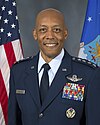Pacific Air Forces
| Pacific Air Forces | |
|---|---|
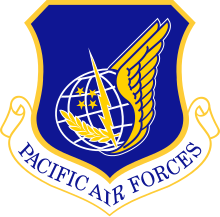 Shield of Pacific Air Forces | |
| Active | 31 July 1944 – present (79 years, 8 months) Detailed
|
| Country | |
| Transport | C-12J, C-17A, C-37A, C-40B, C-130H |
| Tanker | KC-135R |
The Pacific Air Forces (PACAF) is a
The mission of Pacific Air Forces is to provide ready air and space power to promote U.S. interests in the Asia-Pacific region during peacetime, through crisis, and in war. PACAF organizes, trains, and equips the 45,000 Total Force personnel of the
The command's area of responsibility extends from the west coast of the United States to the east coast of Asia and from the Arctic to the Antarctic, more than 100,000,000 square miles (260,000,000 km2). The area is home to nearly two billion people who live in 44 countries.
History
Far East Air Forces
The beginnings of PACAF can be traced back to June 1944, when
The
Far East Air Forces (FEAF) was activated on 3 August 1944, at
The creation of FEAF consolidated the command and control authority over
With the end of World War II in September 1945, the USAAF found its units deployed throughout the Pacific, from Hawaii to
- Fifth Air Force: Assigned to Tokyo, Japan
- Primary mission performing allied occupational assistance on the Korean peninsula.
- Seventh Air Force: Assigned to Hickam Field, Hawaii
- Returning to its prewar mission for the defense of the Hawaiian Islands, including Midway Island; the Marshall Islands and other Central Pacific islands
- Eighth Air Force: Assigned to Okinawa
- Defense of the Ryukyu Islands, including Iwo Jima
- Thirteenth Air Force: Assigned to Clark Field, Philippines
- Defense of the Philippines, New Guinea and the Solomon Islands
- Twentieth Air Force: Assigned to Harmon Field, Guam, Mariana Islands
- Reassigned to PACUSA 6 December 1945; provided a strategic deterrent for the entire Western Pacificregion
With this realignment and reassignment of forces, PACUSA controlled and commanded all United States Army Air Forces in the Far East and Southwest Pacific, and all air forces were placed under one Air Force commander for the first time.[15][16][17]
In November 1945, the
The major mission of PACUSA in the postwar years (1946–1950) was occupation duty in Japan and the demilitarization of the Japanese society in conjunction with the United States Army. In addition, PACUSA helped to support atomic bomb testing in the Pacific Proving Grounds beginning with the Operation Crossroads test on Bikini Atoll in the Marshall Islands in 1946.

With the impending establishment of the United States Air Force as an independent service later that year, PACUSA was redesignated Far East Air Forces (FEAF) on 1 January 1947. On that same date, Seventh Air Force in Hawaii was inactivated with its organization absorbed by HQ, FEAF.[18]
USAF established
Coinciding with the establishment of the
Korean War
On 25 June 1950, the armed forces of the
Order of Battle, June 1950
Despite the post-World War II demobilization of United States armed forces, the United States Air Force still had substantial forces in the Pacific to oppose the North Korean military. When the North Koreans crossed the 38th parallel on 25 June 1950, FEAF consisted of the following primary units*:[20][21][22]
|
|
At that time, the combat units of the FEAF were equipped with the
* Elements of the 2d and 3d Air Rescue squadrons, attached to FEAF by the
** The 31st Photo Reconnaissance Squadron was a
In response to the threat posed by the introduction of Soviet-built (and often Soviet-manned)
Cold War
With the 1953 Korean Armistice, the deployed SAC and TAC units to Japan and Korea were gradually withdrawn, and returned to the United States. Twentieth Air Force was inactivated on 1 March 1955, leaving FEAF with two Air Forces, the Fifth in Japan and the Thirteenth in the Philippines, although units were maintained on Guam and Okinawa.[20]
PACAF established
On 1 July 1954, Pacific Air Force was activated at
On 1 October 1955, the Far East Air Materiel Command was transferred from Far East Air Forces to Air Force Materiel Command.
Tensions between the
By 1960, PACAF maintained a combat-ready deterrent force of some 35 squadrons, operating from 10 major bases in a half-dozen countries.[20]
Vietnam War




In the early 1960s, communist military strength and firepower in Vietnam increased. As a result, PACAF began a buildup in the area with the addition of troops and better arms and equipment.
In response to what has become known as the Gulf of Tonkin incident in 1964, Tactical Air Command (TAC) pilots, navigators and support personnel found themselves deployed from the CONUS to PACAF bases such as Da Nang Air Base and Phan Rang AB in South Vietnam. Takhli Royal Thai Air Force Base and Korat Royal Thai Air Force Base in Thailand were also used by deployed TAC fighter squadrons.[28]
As the American effort in Southeast Asia increased, TAC permanently reassigned entire wings of aircraft from CONUS bases to PACAF and increased the number of rotated tactical fighter and reconnaissance squadrons on rotating Temporary Duty (TDY) commitments to PACAF bases in Vietnam and Thailand, along with units to South Korea, Japan and the Philippines. On a daily basis, flight crews would hurl themselves and their planes at targets across the area of operations over the skies of North and South Vietnam.[28]
At the height of the Vietnam War (1968), PACAF commanded forces at major air bases in the following countries:[29]
- Japan (Fifth Air Force)
- South Korea (Fifth Air Force)
- Philippines (Thirteenth Air Force)
- Taiwan (Thirteenth Air Force)
- South Vietnam (Seventh Air Force)
- Thailand (Seventh/Thirteenth Air Force)
In 1962, PACAF activated the
By 1970, direct PACAF involvement the war was winding down as the conflict was being increasingly turned over to the South Vietnamese under the process known as

Post Cold War

The post-Vietnam era found the command focusing on improving its readiness and PACAF's organizational structure saw a marked period of rapid and extensive changes. Inactivated at the end of the Vietnam War in 1975,
In 1992, changes took place in force structure within PACAF as the command assumed control of theater-based tactical airlift wings, theater C-130 aircraft and crews, and associated theater C-130 support following the disestablishment of Military Airlift Command (MAC). PACAF also gained control of all operational support aircraft and all aeromedical airlift assets in the Pacific previously under the cognizance of MAC.[20] With the concurrent disestablishment of Strategic Air Command (SAC) and Tactical Air Command (TAC) the same year, PACAF also assumed responsibility for all active KC-135 aerial refueling aircraft based in Hawaii and Japan, "gaining command" responsibility for all Air National Guard KC-135 aircraft in Hawaii and Alaska, and all E-3 AWACS aircraft in Japan and Alaska.
Throughout its history PACAF has played a vital role in world events. In addition to its key combat role in World War II, Korea and Vietnam, PACAF units fought in
Since 1944, the command has also participated in more than 140 humanitarian operations within its area of responsibility and beyond. In these operations PACAF people quickly and efficiently airlifted food, medicine and other supplies to areas devastated by storms, floods, earthquakes, volcanoes and other natural disasters.[20]
As PACAF entered the second decade of the 21st century, expanding theatre challenges and simultaneous resource constraints have forced continuing innovation and adjustments by PACAF in order to meet mission requirements. Previously assigned four numbered air forces, PACAF downscoped to three numbered air forces in September 2012, inactivating
Lineage
- Established as Far East Air Forces (Provisional) on 31 July 1944
- Reestablished: Far East Air Forces on 3 August 1944
- Activated on 3 August 1944
- Redesignated: Pacific Air Command, United States Army, on 6 December 1945
- Redesignated: Far East Air Forces on 1 January 1947
- Redesignated Pacific Air Forces on 1 July 1957
Assignments
- Southwest Pacific Area, 3 August 1944
- US Army Forces, Pacific, 6 December 1945
- United States Air Force, 26 September 1947 – Present
Historical Operational Components
Commands
- Far East Air Forces Bomber Command, Provisional: 8 July 1950 – 18 June 1954
- Far East Air Forces Combat Cargo Command, Provisional: 20 August 1950 – 25 January 1951
- Far East (later, Pacific) Air Service Command, later Far East Air Materiel Command (from 1 January 1947) later, Far East Air Logistics Force): 18 August 1944 – 1 October 1955.[33]
Force
- Japan Air Defense: 1 March 1952 – 1 September 1954
Air Forces
- 3 August 1944 – Present
- 14 July 1945 – 1 January 1947; 5 January 1955 – 1 July 1957; 1 April 1966 – 30 June 1975; 8 September 1986 – Present
- Eighth Air Force: 6 December 1945 – 7 June 1946
- Eleventh Air Force: 9 August 1990 – Present
- Thirteenth Air Force: 3 August 1944 – 1 June 1955; 1 July 1957 – 28 September 2012
- Twentieth Air Force: 6 December 1945 – 1 March 1955
Air Divisions
- 1st Bombardment Division (later: 1st Air Division): 7 June 1946 – 1 December 1948
- 2d Air Division: 10 September – 10 October 1962; 8 July 1965 – 1 April 1966
- 17th Air Division. 17 1 July 1975 – 1 January 1976
- 85th Air Division: 11 May 1945 – 1 September 1945
- 91st Air Division: 8 August 1944 – 27 January 1946
- 314th Air Division: 18 May 1951 – 1 March 1952
- 315th Air Division: 25 January 1951 – 15 April 1969
- 326th Air Division: 1 July 1957 – 15 February 1989
- 327th Air Division: 26 January – 8 February 1966
Wings
- 8th Tactical Fighter Wing: 18 June – 8 July 1964
- 18th Fighter Wing: 1 December 1948 – 16 May 1949
- 19th Bombardment Wing: 16 May – 17 October 1949
- 27th Fighter-Escort Wing: attached, 19–29 November 1950 and 6–13 October 1952
- 35th Tactical Fighter Wing: 14 March – 8 April 1966
- 322d Troop Carrier Wing: 30 December 1944 – 15 February 1946
Stations
- Brisbane, Australia, 3 August 1944
- Hollandia, New Guinea, 16 September 1944
- Leyte, Philippines, 7 February 1945
- Tolosa, Leyte, Philippines, 17 February 1945
- Fort William McKinley, Leyte, Philippines, 20 March 1945
- Tokyo, Japan, 17 May 1946
- Fuchu AS, Japan, 13 May 1956
- Hickam AFB, Hawaii, 30 June 1957 – Present
- Ching Chuan Kang Air Base, Taiwan, 8 January 1954 – April 1979
Commanders, Pacific Air Forces
| No. | Commander | Term | |||
|---|---|---|---|---|---|
| Portrait | Name | Took office | Left office | Term length | |
| 1 | General Laurence S. Kuter | 1 July 1957 | 1 August 1959 | 2 years, 31 days | |
| 2 | General Emmett O'Donnell Jr. | 1 August 1959 | 1 August 1963 | 4 years | |
| 3 | General Jacob E. Smart | 1 August 1963 | 1 August 1964 | 1 years | |
| 4 | General Hunter Harris Jr. | 1 August 1964 | 1 February 1967 | 2 years, 184 days | |
| 5 | General John D. Ryan | 1 February 1967 | 1 August 1968 | 1 year, 182 days | |
| 6 | General Joseph J. Nazzaro | 1 August 1968 | 1 August 1971 | 3 years | |
| 7 | General Lucius D. Clay Jr. | 1 August 1971 | 1 October 1973 | 2 years, 61 days | |
| 8 | General John W. Vogt Jr. | 1 October 1973 | 1 July 1974 | 273 days | |
| 9 | General Louis L. Wilson Jr. | 1 July 1974 | 3 June 1977 | 3 years, 2 days | |
| 10 | Lieutenant General James A. Hill | 3 June 1977 | 15 June 1978 | 347 days | |
| 11 | Lieutenant General James D. Hughes | 15 June 1978 | 8 June 1981 | 2 years, 358 days | |
| 12 | Lieutenant General Arnold W. Braswell | 8 June 1981 | 8 October 1983 | 2 years, 122 days | |
| 13 | General Jerome F. O'Malley | 8 October 1983 | 25 September 1984 | 353 days | |
| 14 | General Robert W. Bazley | 25 September 1984 | 16 December 1986 | 2 years, 82 days | |
| 15 | General Jack I. Gregory | 16 December 1986 | 22 July 1988 | 1 year, 219 days | |
| 16 | General Merrill McPeak | 22 July 1988 | 5 November 1990 | 2 years, 106 days | |
| 17 | General Jimmie V. Adams | 19 February 1991 | 22 January 1993 | 1 year, 338 days | |
| 18 | General Robert L. Rutherford | 22 January 1993 | 12 October 1994 | 1 year, 263 days | |
| 19 | General John G. Lorber | 12 October 1994 | 7 July 1997 | 2 years, 268 days | |
| 20 | General Richard B. Myers | 7 July 1997 | 23 July 1998 | 1 year, 16 days | |
| 21 | General Patrick K. Gamble | 23 July 1998 | 9 April 2001 | 2 years, 260 days | |
| — | Lieutenant General Lansford E. Trapp Acting | 9 April 2001 | 4 May 2001 | 25 days | |
| 22 | General William J. Begert | 4 May 2001 | 2 July 2004 | 3 years, 59 days | |
| 23 | General Paul V. Hester | 2 July 2004 | 30 November 2007 | 3 years, 151 days | |
| 24 | General Carrol Chandler | 30 November 2007 | 19 August 2009 | 1 year, 262 days | |
| 25 | General Gary L. North | 19 August 2009 | 3 August 2012 | 2 years, 350 days | |
| 26 | General Herbert J. Carlisle | 3 August 2012 | 16 October 2014 | 2 years, 74 days | |
| 27 | General Lori Robinson | 16 October 2014 | 11 May 2016 | 1 year, 270 days | |
| – | Lieutenant General Russell J. Handy[34] Acting | 11 May 2016 | 12 July 2016 | 62 days | |
| 28 | General Terrence J. O'Shaughnessy | 12 July 2016 | 24 May 2018 | 2 years, 14 days | |
| – | Lieutenant General Jerry P. Martinez Acting | 24 May 2018 | 26 July 2018 | 63 days | |
| 29 | General Charles Q. Brown Jr. | 26 July 2018 | 8 July 2020 | 1 year, 348 days | |
| 30 | General Kenneth S. Wilsbach | 8 July 2020 | 9 February 2024 | 3 years, 216 days | |
| 31 | 9 February 2024 | Incumbent | 69 days | ||
Component units
Pacific Air Forces comprises the following wings and major units.[35][36]
- Headquarters Pacific Air Forces (Joint Base Pearl Harbor–Hickam, Hawaii)
- 319th Expeditionary Reconnaissance Squadron, Kanoya Air Field, Japan, established October 2022 (UAVs).
Fifth Air Force
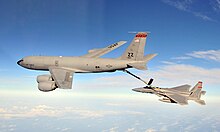
The Fifth Air Force is responsible for USAF operations in Japan. Its role is to defend Japan, respond to regional events, and enhance the U.S. and Japan Mutual Defense Assistance Agreement alliance between the U.S. and Japan.[37]
Permanent units
- Headquarters Fifth Air Force (Yokota Air Base, Japan)
- 18th Wing (Kadena Air Base, Japan) – E-3B/C Sentry, HH-60G Pave Hawk, F-15C/D Eagle, E-8C J-STARS and KC-135R Stratotanker
- 35th Fighter Wing (Misawa Air Base, Japan) – F-16CJ/DJ Fighting Falcon
- 374th Airlift Wing (Yokota Air Base) – C-12J Huron, C-130J Hercules and UH-1N Iroquois
- 605th Air Operations Group (Yokota Air Base)
Seventh Air Force (Air Forces Korea)
The Seventh Air Force contributes to maintaining the armistice between South Korea and North Korea.[38]
Permanent units
- Headquarters Seventh Air Force (Osan Air Base, South Korea)
- 8th Fighter Wing (Kunsan Air Base South Korea) – F-16C/D Fighting Falcon
- 51st Fighter Wing (Osan Air Base) – A-10C Thunderbolt II and F-16C/D Fighting Falcon
- 607th Air and Space Operations Center(Osan Air Base)
- 607th Air Support Group (Osan Air Base)
- 607th Air Support Operations Group (Osan Air Base)
- 607th Support Group (Osan Air Base)
Eleventh Air Force

The Eleventh Air Force is responsible for USAF operations across the Pacific, including the states of Alaska and Hawaii and the US territory of Guam.[39]
Permanent units
- Headquarters 11th Air Force (Joint Base Elmendorf-Richardson, Alaska)
- E-3B Sentry
- C-40A, F-22A Raptor
- 36th Wing (Anderson AFB, Guam)
- 611th Air and Space Operations Center(Joint Base Elmendorf-Richardson)
- 611th Air Support Group(Joint Base Elmendorf-Richardson)
- 613th Air and Space Operations Center(Joint Base Pearl Harbor–Hickam)
- 613th Support Group (Joint Base Pearl Harbor–Hickam)
- 673rd Air Base Wing (Joint Base Elmendorf-Richardson)
- Pacific Air Forces Regional Support Center (Joint Base Elmendorf-Richardson)
Expeditionary units
- 13th Air Expeditionary Group (Christchurch International Airport, New Zealand and McMurdo Station, Antarctica) – C-17A Globemaster III and LC-130 Hercules
Air Force Reserve
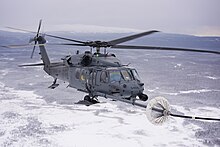
Pacific Air Forces has operational "gaining command" responsibility for several Air Reserve Component (ARC) units, comprising personnel and aircraft from Air Force Reserve Command (AFRC) and the Air National Guard (ANG).
- Joint Base Elmendorf-Richardson) – F-22A Raptor
- 624th Regional Support Group (Joint Base Pearl Harbor–Hickam and Andersen AFB)
- 701st Combat Operations Squadron (March Air Reserve Base, California and Joint Base Pearl Harbor–Hickam)
- C-17A Globemaster III, HC-130J Combat King II and HH-60G Pave Hawk
- KC-135R Stratotanker
- Alaska Rescue Coordination Center (Joint Base Elmendorf-Richardson)
- 254th Air Base Group (Andersen AFB)
- 109th Air Operations Group (Joint Base Pearl Harbor–Hickam)
- 154th Wing (Joint Base Pearl Harbor–Hickam) – C-17A Globemaster III, F-22A Raptor and KC-135R Stratotanker
- 201st Air Operations Group (Joint Base Pearl Harbor–Hickam)
- 298th Air Defense Group (Wheeler Army Airfield, Hawaii)
Other units
- USAF Band of the Pacific – Asia (Yokota Air Base)
- USAF Band of the Pacific – Hawaii (Joint Base Pearl Harbor–Hickam)
See also
- Republic of Korea Armed Forces
- United States Air Force in South Korea
- United States Air Force in Thailand
- United States Army Air Forces in Australia
- United States Forces Korea (USFK)
- United States Taiwan Defense Command (USTDC)
Notes
- ^ a b c "Pacific Air Forces (USAF) > Air Force Historical Research Agency > Display".
- ^ "Pacific Air Forces > Pacific Air Forces > Display".
- ^ "Archived copy" (PDF). Archived from the original (PDF) on 26 April 2018. Retrieved 31 January 2018.
{{cite web}}: CS1 maint: archived copy as title (link) - ^ "Leadership".
- ^ "Leadership".
- ^ "Leadership".
- ^ "AIR VICE-MARSHAL CARL NEWMAN".
- ^ "Leadership".
- ^ "GENERAL GEORGE CHURCHILL KENNEY > Air Force > Biography Display".
- ^ Griffith 1998, pp. 174–175.
- ^ Stephens 2001, pp. 168–170.
- ^ Kenney 1949, pp. 537–538.
- Battle of the Philippines (1941–42) and the surviving personnel and aircraft were later reorganized in Australia as the U.S. Fifth Air Force.
- ^ Globalsecurity.org, PACAF History Fact Sheet
- ^ "Chronology of the Occupation".
- ^ "HyperWar: Army Air Forces in WWII: Volume VII: Services Around the World [Chapter 17]". ibiblio.org.
- ^ "USAF Historical Research Agency". Archived from the original on 24 October 2008.
- ^ "PACAF page, AFHRA". Archived from the original on 24 October 2008.
- ^ American Caesar, Douglas MacArthur 1880–1964, William Manchester, Little, Brown, 1978.
- ^ a b c d e f g h Air Force Historical Research Agency PACAF History Factsheet Archived 24 October 2008 at the Wayback Machine
- ^ Final Cut: The Postwar B-17 Flying Fortress: The Survivors, Scott A. Thompson, Pictorial Histories Publishing Company, 1993.
- ISBN 0-912799-12-9
- ^ Dean Hess
- ^ Bout One
- ^ "Korean Service 1950-1954". afhra.maxwell.af.mil. Archived from the original on 23 December 2007. Retrieved 11 January 2022.
- ^ "Second Taiwan Strait Crisis". www.globalsecurity.org.
- ^ 1960 Presidential Debates @ CNN.com Archived 13 September 2008 at the Wayback Machine
- ^ ISBN 1-59114-933-9.
- ^ a b c Schlight, John (1996) A War Too Long: The History of the USAF in Southeast Asia, 1961–1975, Office of Air Force History, United States Air Force
- ISBN 0-7864-0084-6.
- ^ Kelman, Brett. "AF seeks backup runway in western Pacific." Pacific Daily News, 11 October 2011.
- ^ http://www.mvariety.com/cnmi/cnmi-news/local/71785-air-force-still-mulls-saipan-tinian-alternatives [dead link]
- ^ See lineage and honors at https://ww35.usafunithistory.com/PDF/A-E/AIR%20MATERIAL%20FORCE,%20PACIFIC%20AREA.pdf.
- ^ "O'Shaughnessy Assumes Command of Pacific Air Forces > U.S. Indo-Pacific Command > 2015".
- ^ "PACAF Units". Pacific Air Forces. US Air Force. Retrieved 25 April 2020.
- ^ Kaminski, Tom (2020). "Air Power Review". United States Air Force – Air Power Yearbook 2020. Key Publishing. pp. 78, 79, 83, 86, 88–91, 92.
- ^ "About Us". Fifth Air Force. US Air Force. Retrieved 25 April 2020.
- ^ "Units". Seventh Air Force. US Air Force. Retrieved 25 April 2020.
- ^ "Joint Base Elmendorf-Richardson > Units > Air Force". jber.jb.mil. Retrieved 25 April 2020.
References
![]() This article incorporates public domain material from the Air Force Historical Research Agency
This article incorporates public domain material from the Air Force Historical Research Agency
- This article includes content from Pacific Air Forces website, which as a work of the U.S. Government is presumed to be a public domain resource. That information was supplemented by:
- Endicott, Judy G. (1999) Active Air Force wings as of 1 October 1995; USAF active flying, space, and missile squadrons as of 1 October 1995. Maxwell AFB, Alabama: Office of Air Force History. CD-ROM
- Fletcher, Harry R. (1989) Air Force Bases Volume II, Active Air Force Bases outside the United States of America on 17 September 1982. Maxwell AFB, Alabama: Office of Air Force History. ISBN 0-912799-53-6
- Ravenstein, Charles A. (1984). Air Force Combat Wings Lineage and Honors Histories 1947–1977. Maxwell AFB, Alabama: Office of Air Force History. ISBN 0-912799-12-9.
- Rogers, Brian (2005). United States Air Force Unit Designations Since 1978. Hinkley, England: Midland Publications. ISBN 1-85780-197-0.
- USAAS-USAAC-USAAF-USAF Aircraft Serial Numbers—1908 to present
External links
- Pacific Air Forces (official site)
- PACAF Pixels (command blog)
- USA Pacific Air Command, Army Institute of Heraldry

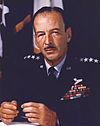


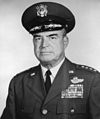



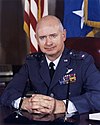



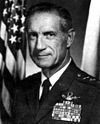

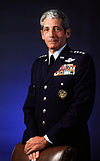

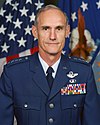




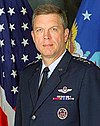




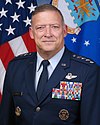


![Russell J. Handy[34]](http://upload.wikimedia.org/wikipedia/commons/thumb/8/8e/LIEUTENANT_GENERAL_RUSSELL_J._HANDY_USAF.JPG/100px-LIEUTENANT_GENERAL_RUSSELL_J._HANDY_USAF.JPG)


